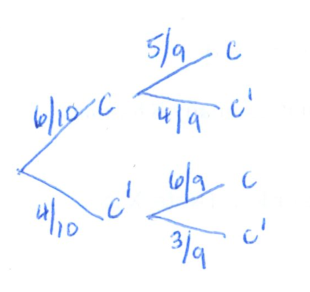01
(1) Use the Law of Total Probability to find
(2) Use Bayes’ Theorem to find
(3) Use Bayes’ Theorem to find
(4) Use Bayes’ Theorem to find
02
Label the two ‘more qualified’ as A, B, and the three ‘less qualified’ as C, D, E.
9 options have at least one less qualified. 3 options have both less qualified.
Answer
03
Let A be a syntax error and B a logic error.
04
(1) Define events.
Let
Let
We are given the probabilities
We are asked to compute
(2) Set up formula
(3) Plug in values.
05
(1) Define events.
Let
We are asked to compute
(2) Define obvious probabilities.
(3) Use Bayes’ Theorem to set up the formula for
(4) Plug in values and solve.
06
(a)
Letters in
(b)
Letters in
07
(1) Use inclusion-exclusion principle.
(2) Use the fact that they are mutually independent.
08
(1) Find probabilities for individual events.
(2) Compute pairwise probabilities.
The only way
The only way
The only way
(3) Disprove mutual independence.
09
(a)
(1) Define events.
We define the sample space as
(2) Compute
(b)
(1) We are asked to compute
(2) Find probabilities for all relevant combinations.
(3) Plug in values.
10
(a)
If the order matters, then we are dealing with a permutation.
We want
(b)
If the order matters, then we are dealing with a combination.
We want
11
(1) Consider how the days are chosen.
Since we just want two days out three given days, it is unordered, so we account for this with the
(2) Consider the probability that Wisconsin’s flag is hung on the first two days, and not the third.
The probability that Wisconsin’s flag is hung up is
Therefore, the desired probability is
(3) Combine terms.
12
(1) Define relevant events.
If two balls of different colors are drawn out, then we choose one of each color.
Since order doesn’t matter, our sample space consists of all the ways we choose 2 balls out of 7.
(2) Compute probability.
13
(a)
(b)
14
15
16
(a)
Let
(b)
Similarly to part (a), we have
17
(1) State the inclusion-exclusion principle.
(2) Examine the maximum value of
We know that
Given that
(3) Examine the minimum value of
The minimum value of
Therefore,
18
(a)

Note:
(b)
(c)